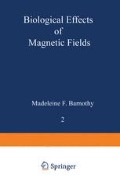Abstract
Information on the biological capacity of mammals and other biosystems under anomalous conditions is necessary in assessing the biological cost of a task or occupation. The fact that man has resided in magnetic fields without experiencing obvious harmful effects should not preclude a detailed, systematic assessment of magnetic environments and their possible bioeffects. Interest in magnetic shielding of astronauts against cosmic radiation raises the question of bioeffects of strong magnetic fields. High-intensity magnetic fields can be expected in connection with ion and other advanced propulsion systems. Even with proper shielding and arrangement of such fields, the possibility of fringe and/or accidental exposure requires experience with bioeffects of high-intensity magnetic fields.(1)
This work was supported by the General Dynamics Corp. IRAD program.
Access this chapter
Tax calculation will be finalised at checkout
Purchases are for personal use only
Preview
Unable to display preview. Download preview PDF.
References
D. E. Beischer, “Biological effects of magnetic fields in space travel,” in: 12th International Astronautical Congress, Academic Press, New York, p. 515 (1963).
K. Dunlap, “Visual sensations from an alternating magnetic field,” Science 33: 68 (1911).
H. B. Barlow, H. I. Kohn, and E. G. Walsh, “Visual sensations aroused by magnetic fields,” Am. J. Physiol. 148: 372 (1947).
J. M. Barnothy, “Biological effects of magnetic fields,” in: Medical Physics (O. Glasser, ed.) Vol. 3, p. 61, Year Book Medical Publishers, Inc., Chicago (1960).
J. W. Jennings and S. C. Ratner, “Search for effects of magnetic field on activity-wheel behavior of mice,” 2nd International Biomagnetic Symposium, Nov. 29–30, Univ. of Illinois, Chicago (1963).
Author information
Authors and Affiliations
Editor information
Editors and Affiliations
Rights and permissions
Copyright information
© 1969 Plenum Press, New York
About this chapter
Cite this chapter
Russell, D.R., Hedrick, H.G. (1969). Preference of Mice to Consume Food and Water in an Environment of High Magnetic Field. In: Barnothy, M.F. (eds) Biological Effects of Magnetic Fields. Springer, Boston, MA. https://doi.org/10.1007/978-1-4684-8352-9_17
Download citation
DOI: https://doi.org/10.1007/978-1-4684-8352-9_17
Publisher Name: Springer, Boston, MA
Print ISBN: 978-1-4684-8354-3
Online ISBN: 978-1-4684-8352-9
eBook Packages: Springer Book Archive

